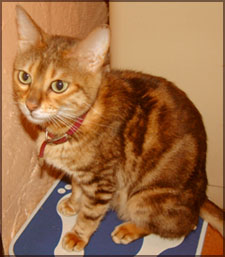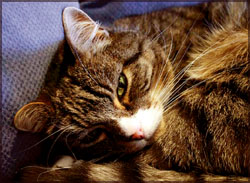|
Let us talk about pets
How is your cat's behaviour?
Ruwini Jayawardana
Cats make great pets for so many
reasons. They are small in size and don't occupy a lot of room. They
preferentially use a litter box so don't have to be walked. They can
often be left at home alone for the day without getting lonely.
Sometimes, they even enjoy the occasional cuddle in bed at night. What's
there not to love?
Ever since their domestication by the ancient Egyptians, feline
companions have been an important element in our societies. Their peculiar behaviour, so different from dogs, has
been a subject of interest for many.
our societies. Their peculiar behaviour, so different from dogs, has
been a subject of interest for many.
By nature, domestic cats are considered to be asocial animals, in
comparison to dogs that are social creatures. Asocial animals (not to
confused with antisocial) live mostly solitary lives, but come together
in groups for two reasons: breeding and raising their young.
Though domestic cats are asocial by nature, they can adapt to living
in groups. Often to resolve conflicts, a threat is made by one
individual and met with a withdrawal by the other. The house is often
divided into zones ("home ranges"), which is why the addition of a new
cat or removal of a resident can be disruptive to the established social
environment. Intact male cats are often aggressive towards each other.
The big question is then, that if cats are loners, why are they
social towards humans? The current theory is that while dogs view and
greet humans as other dogs, cats treat humans like a kitten would its
mother.
It is believed that years of domestication has selected for this
kitten-like behaviour in adult cats. Evidence for this is seen in the
every-day antics of our own feline companions, such as wanting to be
groomed, rubbing of the face against a leg, and kneading of the paws as
if it was kneading its mother while nursing.
Understanding feline behaviour is of huge importance to training a
cat. Behavioural issues deemed unacceptable to us are better dealt with
when the purpose of the behaviour is understood.
 For
example, cats do not interact with people as if they were a part of a
social hierarchy. Therefore, punishment of a cat is useless because they
will not be instinctively submissive. Instead, they will choose to
either escape the situation or stay and fight. For
example, cats do not interact with people as if they were a part of a
social hierarchy. Therefore, punishment of a cat is useless because they
will not be instinctively submissive. Instead, they will choose to
either escape the situation or stay and fight.
Normal behaviours of feral cats, such as tree scratching and urine
spraying, often manifest at home as undesirable behaviour problems. It
is important to realize that these are forms of communication between
cats, and management of such issues requires an understanding of what
they mean.
Scratching vertical surfaces is a behaviour with dual purpose: it is
a form of communication and also a way to remove loose claw fragments or
old claws. At the same time, this behaviour allows the removal of old
nails, in essence, "sharpening" their claws.
This knowledge of the behaviour can be applied to modifying
scratching problems in household pets. If a piece of furniture is being
preferentially scratched by a cat, move the object and place a cover
over it. Because cats favour materials with longitudinally oriented
threads to aid in the removal of nails, a knobby fabric would work best.
Another undesirable behaviour in some cats is urine spraying. This is
especially prevalent in intact male cats. Feral cats are known to spray
vertical objects with urine in order to alert other cats of their
presence.
The freshness of the urine allows neighbours to tract the movement of
the cats in the area, and males may use this in the mating season to
locate females. It is also used to mark home ranges, and cats will often
spray if encountering familiar scents or if anxious.
encountering familiar scents or if anxious.
Look for situations that can produce anxiety, such as the presence of
neighbourhood cats at the window or a household that is too crowded.
Reducing the chances of anxiety will likely decrease the amount of urine
spraying.
By understanding the behaviours of the domestic cat, we are able to
form a closer bond with our feline friends. Although cats are asocial
towards each other, they are wonderful companions because of their
friendly social behaviour towards humans. |
